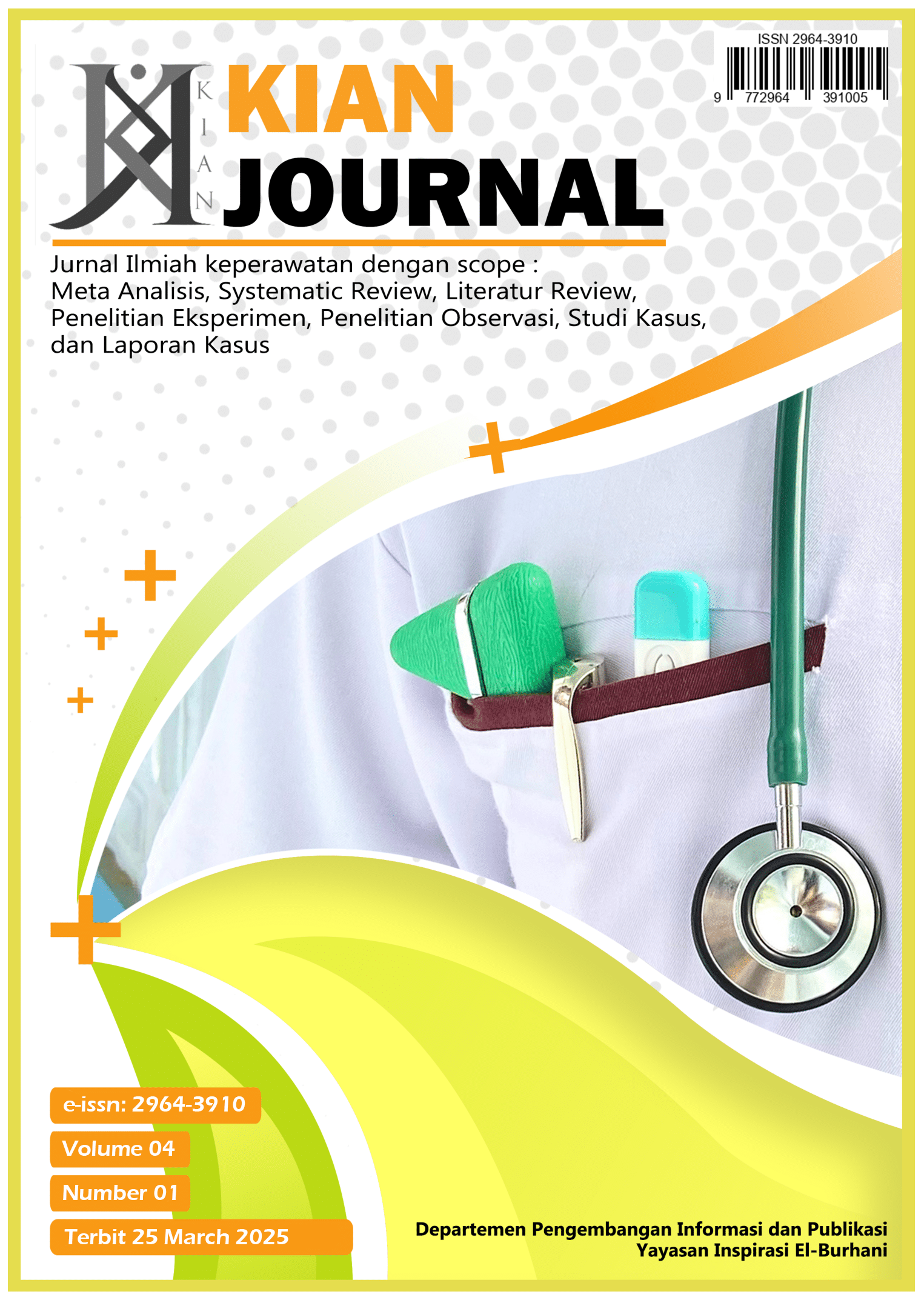Implementation Of Wound Care Education In A Diabetic Ulcer Patient With Knowledge Deficits
DOI:
https://doi.org/10.56359/kian.v4i1.553Keywords:
Diabetes Mellitus, diabetic ulcer, Wound Care EducationAbstract
Background: Diabetes mellitus is a metabolic disease that can cause various complications, one of which is diabetic ulcers. These ulcers occur due to impaired circulation and peripheral neuropathy which causes wounds to heal. In an effort to manage diabetic ulcers, an educational approach is needed to increase patient awareness of the importance of proper wound care and infection prevention efforts. Nursing education plays an important role in helping patients understand the relationship between uncontrolled blood glucose levels and the impaired wound healing process. Increased patient understanding is expected to encourage behavioral changes in self-care and improve compliance with medical recommendations.
Objectives: This case study aims to evaluate the implementation of wound care education with impaired knowledge deficits in diabetic ulcer patients through a nursing approach. This research method is in the form of a case study using a descriptive
Method: with a research design using a nursing care approach which includes assessment, nursing diagnosis, nursing intervention, nursing implementation, nursing evaluation which is carried out for 3 meetings at the patient's home in the rose ray neighborhood, RT. 001 RW. 008, cigembor village, ciamis sub-district
Results: After implementing education for three meetings, the results showed that the client's understanding of wound care had increased. The client showed the ability to recite the correct wound care steps, recognize signs of infection, and understand the importance of controlling blood glucose levels in accelerating wound healing. The family also began to play an active role in assisting the wound care process at home.
Conclusion: The implementation of wound care education can improve client knowledge and skills in caring for diabetic ulcers to prevent infection. This education can be an important part of promotive and preventive nursing interventions to support the wound healing process and prevent further complications.
Downloads
References
Almaini, A., & Heriyanto, H. (2019). The effect of diet compliance, physical activity, and medication on changes in blood sugar levels in Rejang ethnic diabetes mellitus patients. Raflesia Nursing Journal, 1(1), 55–66.
Asmaria, M., Marni, L., & Hafni, S. Y. (2022). Education on the Care of Diabetic Ulcers at Home for Patients and Their Families at Asyiyah Hospital in Pariaman City. Abdimas Saintika Journal, 4(1), 41–45.
Harun, H., Purba, C. I. H., Fitri, S. U. R., & Widayat, A. (2024). Improving Family Knowledge and Independence in Wound Care. Journal of Community Service Creativity (PKM), 7(3), 1351–1362.
Lutfikasari, H. (2024). Literature Review: “The Effect of Maggots (Lucilia Sericata) on Wound Healing in Diabetes Mellitus Patients.”
Permatasari, W., Firmansyah, A., Hidayat, N., Purwati, A. E., Supriadi, D., & Setiawan, H. (2023). Studi Kasus Status Nutrisi pada Penderita Diabetes Melitus. INDOGENIUS, 2(2), 56-63.
Putri, A. C. (2024). The Relationship Between the Duration of Diabetes Mellitus and Foot Care with the Risk of Diabetic Foot Ulcers at the Bangetayu Health Center in Semarang. Sultan Agung Islamic University, Semarang.
Raihan, S. A. (2023). Application of Handwashing Using Antiseptic Solution in Wound Care to Prevent Infection in Patient Mr. A with Left Humerus Fracture on the 5th Floor of the Eri Sadewo Pavilion, Gatot Soebroto Army Hospital, 2023.
Rewasan, M., Langi, F. L. F. G., & Kalesaran, A. F. C. (2022). An ecological study of central obesity with diabetes mellitus among individuals over 15 years of age in Indonesia. KESMAS: Journal of Public Health, University of Sam Ratulangi, 11(1).
Sulistya Muvarizka, N. (2023). Comparison of diabetic foot ulcer prevention behavior among diabetes mellitus patients at Tlogosari Kulon Community Health Center and Bangetayu Community Health Center in Semarang City. Sultan Agung Islamic University, Semarang.
Sulistyawati, W., & Hilfida, N. H. (2025). Application of SDKI, SLKI, and SIKI in Nursing Care Documentation.
Waluyo, E. M. J., Hidayat, D. A., Supriadi, D., Firmansyah, A., & El Haque, I. T. (2019). The Influence of the Four Pillars of Diabetes Mellitus Control on Complications in Diabetes Mellitus Patients. JURNAL VNUS (Vocational Nursing Sciences), 1(2), 52-62.
Widodo, W., Muzaki, A., Anggoro, W. Y., & Dafiyanti, A. (2024). Foot Ulcer Prevention Behavior in Diabetes Mellitus Patients. Nursing Journal, 16(2), 609–614.
Downloads
Published
How to Cite
Issue
Section
License
Copyright (c) 2025 Riska Fitri Oktavianti, Ade Fitriani, Lilis Lismayanti

This work is licensed under a Creative Commons Attribution 4.0 International License.














